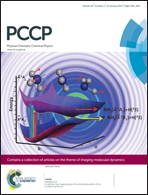Tuning excited-state proton transfer dynamics of a 3-hydroxychromone dye in supramolecular complexes via host–guest steric compatibility†
Abstract
The photophysics of 2-(2′-benzofuryl)-3-hydroxychromone (BFHC) is remarkably modulated in its complexes with macrocyclic hosts such as β-cyclodextrin (β-CD), hydroxypropyl-β-cyclodextrin (HP-β-CD) and methyl-β-cyclodextrin (M-β-CD). BFHC exhibits dual emission bands, attributable to excited normal (N*) and tautomer (T*) forms, where the latter originates from the former through an excited-state intramolecular proton transfer (ESIPT) reaction. Fluorescence lifetimes of the tautomer, along with the intensity ratio (IT*/IN*) of the dual emission bands, and the fluorescence quantum yield (Φ) of the dye, increase significantly in the order β-CD < HP-β-CD < M-β-CD to indicate increasing hydrophobicity of the dye environment in the host CD cavity. In accordance with this increasing hydrophobicity of the dye environment, the ESIPT dynamics of BFHC becomes increasingly fast in the host cavity in the order β-CD < HP-β-CD < M-β-CD. Binding constant data and molecular modeling studies indicate that the increasing order of the faster ESIPT dynamics originates from an increasingly tight host–guest spatial fit, which causes increasingly strong dehydration of the BFHC dye. Steric compatibility in size and shape between the host cavity and the guest, which modulates the tightness of the host–guest spatial fit and hence the extent of hydration, is a key factor for tuning the proton transfer dynamics since water molecules perturb the ESIPT reaction and quench the fluorescence of BFHC.


 Please wait while we load your content...
Please wait while we load your content...